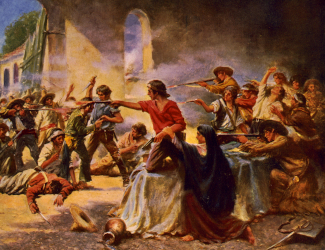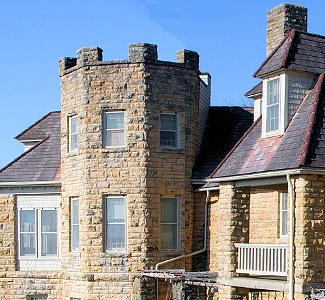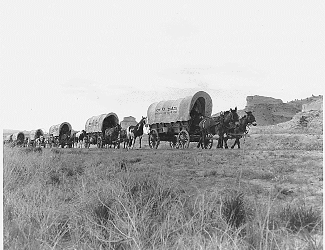Sponsor this page. Your banner or text ad can fill the space above.
Click here to Sponsor the page and how to reserve your ad.
-
Timeline
1834 - Detail
March 18, 1834 - Pennsylvania's Main Line canal was linked between Philadelphia and Pittsburgh by a system of ten inclined planes which crossed the Allegheny Mountains and began operations.
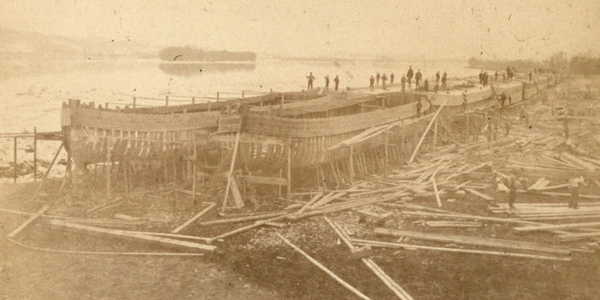
It was not unusual for the states of the new United States to seek transportation across their land that was easier than horse, buggy, and wagon. Thus all over the northeast, canals and railroads were combining their talents to provide such for goods, services, and people. There are the more famous; the Erie Canal in New York, and the lesser known, but equally important to their region. For the Keystone State, the Pennsylvania Main Line Canal would run the width of Pennsylvania, using waterways and locks, then railroad incline planes, ten, to cross the Allegheny Mountains, until it could reach water and locks on the western side toward Pittsburgh.
There were smaller canals built prior such as the Conewaga Canal, built in 1797 below York Haven, to circumvent the Conewaga Falls. Over the next thirty years, canals wound throughout the commonwealth like a labrynth, connecting them to railroads. A more coordinated connection was becoming a necessity, however, as the Erie Canal gave New York state a great advantage in transporting goods from east to west. Thoughts of building a state wide canal began in earnest in 1813 when David Reid and James Clarke brought the proposal to the state legislature. They were turned down. Advocacy from the press and other leaders took a decided pro lean when the Erie Canal began construction in 1817. This advocacy was predominantly from the Pittsburgh area, attempting to convince Philadelphia merchants that it would be good for business. They were not interested. The state thought the project was too costly, so they attempted, at a Washington, D.C. canal convention to get federal money on November 6, 1823. The feds would not fund it. This would have to be a state project.
The state assembly began to study the project more intently once they were turned down in Washington. By March 27, 1824, a canal construction bill had passed. However, a three man commission appointed to pick the route could not agree. Susquehanna to Juniata in the east and Conewaugh, Kiskeminetas, and Allegheny in the west was favored by two; the other commissioner wanted to build a railroad. After much harangue, the canal was chosen, although the route still undecided. Perhaps they should have built the railroad.
On July 4, 1826, Governor George Schultz planted the first spade at Harrisburg, and thus the Pennsylvania Canal began construction. At the Allegheny Front in the Allegheny Mountains, a railroad would be needed. Known as the Allegheny Portage Railroad, it would need ten incline plains to cross the barrier's thirty-four miles. This was completed in 1834 and the Pennsylvania Main Line Canal was now in operation.
The Allegheny Portage Railroad was a political decision, necessary for Pennsylvania in its battle with New York and the Erie Canal. It would carry boats from the basin at Hollidaysburg to the canal at Johnstown then to the Conewaugh River. There were three canal divisions and two railroads involved; the Philadelphia and Columbia and the Allegheny Portage.
Constructing the canal, or any canal, was a labor intensive task, and very expensive. The first estimate was $500,000 per year for six years. Between waste of money from the contractors, who cheated the state, the final number was much larger. To dig the canal, forty feet wide at the top, twenty-eight feet at the bottom, with a four foot deep minimum draw, may have been the most arduous, and for the canals in Pennsylvania, many of the workers were Irish immigrants, but the subsequent structures also had to be constructed. Lockkeepers houses, lift docks, aqueducts, reservoirs, canal basins, tow-paths, and tow-path bridges were also on the docket. The locks were ninety feet long and fifteen to seventeen feet wide. But despite all these, within six years, 1840, the Pennsylvania Canal would cover seven hundred and twenty-six miles of canals, railroads, and inclines, including all canals in the state.
A board, the Board of Canal Commissioners, overseeing the canals had been established on April 11, 1825. They were not only involved in the construction of the canals, but also their maintenance.
Finally the canal could begin making money. Tolls varied according to the item, from sand, earth, and manure at 75% of a cent to four cents for furs and pelts. Passenger boats cost 25 cents per mile or 10 cents per mile for the boat and 1 cent per mile for passengers over eight. If you wanted to ride on a freight boat, it cost only one-half cent per mile for those over twelve years old.
Unfortunately, for the lovers of the canal life, there was an end date in site. In 1852, the Philadelphia and Reading Railroad began offering Philadelphia to Pittsburgh rail service. They bought the entire Pennsylvania Main Line Canal system for $7.5 million in 1857. The Canal Commission ceased operation two years later. Although freight continued to be carried at a fairly high capacity on some canals through 1875, after that date, the flow of traffic diminished each year. Some canals kept operating, however, into th 1940's. That was not the case for the Pennsylvania Main Line Canal; it ceased operation in 1889.

Other Canals in Pennsylvania's System
It was important in the eastern part of the state to have a canal system that could bring coal down the mountains from Port Carbon to Philadelphia. The Schuylkill River, which basically traversed that course, was used as the basis for a canal system one hundred and eight miles long. It was completed prior to the Pennsylvania Main Line Canal in 1825 after ten years of construction. There were one hundred and twenty locks. In 1870, it was leased to the Philadelphia and Reading Railroad Company for nine hundred and ninety-nine years. They were a bit too excited about the technology lasting that long. The canal was done by 1931.
Detail of the Juniata Division
The Juniata Division of the Pennsylvania Main Line Canal was essential for the development of Central Pennsylvania industry, including the start of its charcoal iron, iron-making, industry. It also drew settlers to this area of Pennsylvania that had previously been scarce. Like other divisions, it proved to be a training ground for the civil engineering trade. Several engineers who worked at the Juniata Division, Canvass White and DeWitt Clinton, Jr. were at the top of their field.
The Juniata Division included twenty-seven waste weirs. These weirs were essential during times of flood, when their sluice gates would discharge excess water from the canal system. Stop locks were also essential to control water during periods of heavy rain, especially at the Lewistown Narrows. In 1832, at Mile 40.5, a stop lock was constructed at the upper end of Section 9. Of course, on the opposite end of water levels were during times of drought. Feeder ponds and spillways, one at Macedonia Run, allowed small streams to empty directly into the canal, ... if there was excess, it would go back into the Juniata River via the stone spillway. A river dam and feeder sluices at the Lewistown Narrows, providing water to 28.5 miles of the canal.
Photo above: Schuylkill Canal boats under construction for the Philadelphia and Reading Railroad Co, circa 1846, along the Susquehanna River. Courtesy Pennsylvania Historical and Museum Commission. Photo below: Two views of the remnants of the Pennsylvania Main Line Canal in the Allegheny section, Historical American Buildings Survey. Courtesy Library of Congress. Info Source: Wikipedia Commons; Library of Congress; Pennsylvania Historical and Museum Commission; National Park Service; "Pennsylvania Main Line Canal," 1992, David Fritz and A. Berle Clemensen.
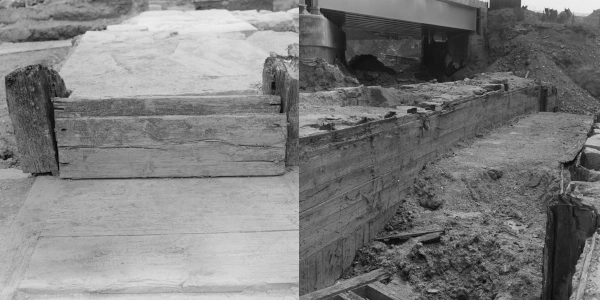
History
Photo Bomb

